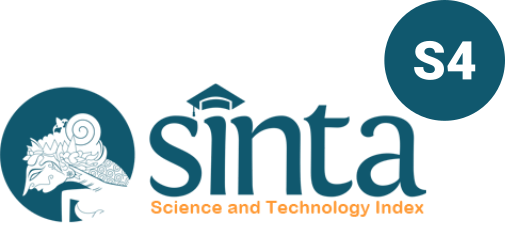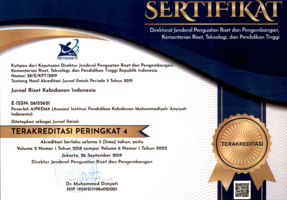Title:
Pengalaman ibu primipara dengan riwayat sectio caesarea dalam pemberian Air Susu Ibu (ASI): scoping review
Author:
Abstract
Latar belakang: Badan Kesehatan Dunia pada tahun 2018 melaporkan bahwa rata-rata angka pemberian ASI eksklusif di dunia adalah 38% sementara target cakupan pemberian ASI yakni 80%. Ibu primipara mempunyai resiko lebih tinggi mengalami kesulitan pada pemberian Air Susu Ibu (ASI) dikarenakan minimnya pengalaman dan persiapan menjadi ibu. Selain faktor primipara, jenis persalinan juga mempengaruhi keberhasilan menyusui secara eksklusif. Ibu dengan post secarean section mempunyai resiko lebih tinggi untuk tidak memberikan ASI eksklusif pada bayinya karena adanya hambatan rasa nyeri dan ketidaknyamanan baik secara fisik maupun emosional. Tujuan penelitian: Untuk melihat gambaran pengalaman ibu dalam melakukan praktik menyusui pada ibu dengan persalinan cesarean section Metode : Metode yang digunakan adalah scooping review yang terdiri dari 5 tahapan, yaitu: melakukan focusing review dengan framework PEOS (Population, Exposure, Outcome dan Study Design), melakukan literature searching menggunakan databases yang relevan. Menyeleksi studi yang relevan menggunakan kriteria inklusi dan ekslusi; melakukan critical appraisal untuk menilai kualitas literature, melakukan data extraksi, menganalisis dan melaporkan hasil. PRISMA Flowchart (Preferred Reporting Items for Systematic reviews and Meta-Analyses), digunakan untuk menggambarkan alur pencarian literature. Hasil : 6 literature terseleksi dan mempunyai Grade A dan B. Dua tema muncul sebagai hasil dari scooping review yaitu faktor yang mempengaruhi dalam pemberian ASI dan dampak tidak melakukan IMD untuk keberlangsungan pemberian ASI. Simpulan: Faktor yang mempengaruhi dalam keberhasilan pemberian ASI yakni jenis persalinan, Inisiasi Menyusui Dini, pengalaman menyusui sebelumnya, kebijakan rumah sakit, paritas, tenaga kesehatan, pengetahuan ibu, dukungan orang terdekat, komplikasi selama persalinan, self efficacy, Budaya dan anggapan masyarakat. Persalinan cesarean section berdampak pada proses laktogenesis II tertunda.
Background: WHO 2018 reported only 38% babies have breastfed exlusively, whilst the target is 80 %. Evidence reveal that primiparous women have higher risk for having difficulties for practicing breastfeeding compare to women who experienced parenting before. Additionally, women with post section secarean also have barriers on practicing breasfeeding due to feeling pain and discomfort after section sectarian. Study Aim: This study aimed to explore breastfeeding practice and experiences amongst women after cesarean section. Methods: Scooping review was applied in this study which involved the steps; focusing review by using PEOS (Population, Exposure, Outcome dan Study Design) framework, literature search in relevant databases, applied inclusion and exclusion criteria to selected relevant studies, critical appraisal to assess quality of selected studies; data extraction; analyzing and data reporting. PRISMA Flowchart (Preferred Reporting Items for Systematic reviews and Meta-Analyses) was used to describes the steps from searching liteartures until studies inclusion. Result: 6 studies with Grade A and B included for review. Two themes emerged which are factors influencing exclusive berastfeeding and outcome of not practicing exclusive breastfeeding. Conclusion: Factors that influence the success of breastfeeding are the type of labor, Early Breastfeeding Initiation, previous breastfeeding experience, hospital policy, parity, health personnel, maternal knowledge, support of the closest person, complications during labor, self efficacy, culture and public opinion. Cesarean section labor has a delayed effect on the process of lactogenesis II.
Keywords
Full Text:
PDFReferences
A Karlstrom., H Lindgren. 2013. Maternal and infant outcome after caesarean section without recorded medical indication : finding from a swedish case-control study
Agboado G, Elaine Michel, Arpana Verma. 2010. Factors Associated with Breastfeeding cessation in Nursing Mother in Peer Support Programme in Eastern Lancashire. Journal BMC Pediatric
Alfianrisa A, Salimo H, and Pamungkasari EP. 2017. Factors Associated with Exclusive Breashfeeding: Application of Precede-Proceed and Theory of Planed Behavior. Journal of Maternal and Child Health, Vol. 2, No. 1, Hlm. 42-53
Alves AL, Oliveira MI, and Moraes JR. 2013. Breashfeeding Friendly Primary Care Unit Initiative and the Relationship with Exclusive Breastfeeding. Revista de Saude Publica, Vol. 47, No. 6, Hlm. 1030-1040
A Karlstrom., H Lindgren. 2013. Maternal and infant outcome after caesarean section without recorded medical indication : finding from a swedish case-control study. Journal International Obstetri and Gynecology.
Atika Z, Salimo H, and Dewi YLR. 2018. Multilevel Analysis on the Determinants on Exclusive Breashfeeding at Gunung Anyar Community Health Center, Surabaya, Indonesia. Journal of Maternal and Child Health, Vol. 3, No. 3, Hlm. 176-183
Arini H. 2012. Mengapa Seorang Ibu Harus Menyusui. Yogyakarta: Flashbook
Arksey H, O'Malley L. Scoping studies: towards a methodological framework. Int J Soc Res Methodol 2005;8(1): 19–32.
Astuti AW and Rosmary M. Intervention Analysis of Addressing Exclusive Breastfeeding (EBF) Barriers to Improve EBF Coverage Among Industrial Woman Employees in Indonesia. Journal of Health Technology Assesment in Midwifery. Vol.1 No.1: 1-16
Bettani-Saltikov, J. 2012. How to do a systematic literature review in nursing : a step-by-step guide. Maidenhead: McGraw-Hill/Open University Press
Bodner K, Wierrani F, Grunberger W, and Adler BB. 2011. Influence of the Mode of Delivery on Maternal and Neonatal Outcomes: A Comparison Between Elective Caesarean Section and Planned Vaginal Delivery in a Low-Risk Obstetric Popupation. Chaplin, J., Kelly, J., Kildea, S., 2016. Maternal perceptions of breastfeeding difficulty after caesarean section with regional anaesthesia: A qualitative study. Women Birth J. Aust. Coll. Midwives
Chaplin, J., Kelly, J., Kildea, S., 2016. Maternal perceptions of breastfeeding difficulty after caesarean section with regional anaesthesia: A qualitative study. Women Birth J. Aust. Coll. Midwives 29, 144–152.
Dachew BA, and Bifftu BB. 2014. Breastfeeding Practice and Associated Factors Among Female Nurses and Midwives at North Gondar Zone, Northwest Ethiopia: A Cros-Sectional Institution Based Study. International Breastfeeding Journal, Vol. 9
David Mukunya, James K Tumwine, Victoria Nankabirwa. 2017. Factors associated with delayed initiation of breastfeeding. Global Health Action, 10:1
El-Houfey AA, Saad K, Abbas AM, Mahmoud SR, and Wadani M. 2017. Factors That Influence Exclusive Breastfeeding: A Literature Review. International Journal of Nursing Didastics, Vol. 7, No. 5
Elyas L, Mekasha A, Admasie A, and Assefa E. 2017. Exclusive Breashfeeding Practice and Associated Factors Among Mother Attending Private Pediatric and Child Clinics, Addis Ababa, Ethipia: A Cross Sectional Study. International Journal of Pediatrics
Fern R. Hauck, John M. D. Thompson, Kawai O. Tanabe, Rachel Y. 2011. Breastfeeding and Reduce Risk of Sudden Infant Death Syndrom : A Meta-analysis. Journal American Academy of Pediatrics
Gabriel Agboado , Elaine Michel, Arpana Verma. 2010. Factors Associated with Breastfeeding cessation in Nursing Mother in Peer Support Programme in Eastern Lancashire. Journal BMC Pediatric
Hung KJ, and Berg O. 2011. Early Skin to Skin After Cesarean to Improve Breashfeeding. American Journal Maternal Child Nursing, Vol. 36, No. 5
Ikatan Dokter Anak Indonesia. 2010. Indonesia Menyusui. Jakarta. Badan Penerbit IDAI
Ikatan Dokter Anak Indonesia (IDAI). Indonesia Pediatric Society. Nilai Nutrisi Air Susu Ibu 2013.
Kiani, S.N., Rich, K.M., Herkert, D., Safon, C., Pérez-Escamilla, R., 2018. Delivery mode and breastfeeding outcomes among new mothers in Nicaragua. Matern. Child. Nutr. 14.
Kitano N, Nomura K, Kido M, Murakami K, Ohtubo T, Ueno M, and Sugimoto M. 2016. Combined Effects of Maternal Age and Parity on Successful Initiation Ofexclusive Breastfeeding. Journal of Preventive Medicine Report 3, Hlm. 121-126
Koopman, I., Callaghan-Koru, J.A., Alaofin, O., Argani, C.H., Farzin, A., 2016. Early skin-to-skin contact for healthy full-term infants after vaginal and caesarean delivery: a qualitative study on clinician perspectives. J. Clin. Nurs. 25, 1367–1376.
Kumar VRH, Jahagirdar SM, and Ravishankar M. 2014. Study of Patient Satisfaction and Self=Expressed Problems After Emergency Caesarean Delivery Under Subarachnoid Block. Indian Journal of Anaesthesia, Vol. 58, No. 2, Hlm. 149-153
Lestari E, Pamungkasari EP, and Dewi YLR. 2019. Multilevel Analysis on the Contextual Effect of Posyandu on Exclusive Breastfeeding in Sleman, Yogyakarta. Journal of Maternal and Child Health, Vol. 4, No. 4, Hlm. 250-259
Levac Danielle, Heather Colquhoun and Kelly K 2010. Scoping Studies : advancing the methodology.
Ly Thi Hai Ngo, Hsueh-Fen Chou, Meeling. 2018. Breastfeeding Self Efficacy and Related Factors in Postpartum. An International Journal Midwifery
Maastrup R, Hansen BM, Kronborg H, Bojesen SN, Hallum K, Frandsen A, Kyhnaeb A, Svarrer I, and Hallstrom I. 2014. Factors Associated with Exclusive Breashfeeding of Preterm Infants: Result from Prespective National Cohort Study. PLOS ONE, Vol. 9, No. 2
Mannion CA, Hobbs AJ, McDonald SW, and Tough SC. 2013. Maternal Perceptions of Partner Support during Breastfeeding. International Breastfeeding Journal, Vol. 8, No. 4
Nisa J, Salimo H, and Budihastuti UR. 2017. Factor Nickerson, E Lauren et al. 2012. Mother’s Experience of Father’s Support for Breastfeeding. Journal Public Health Nutrition, Vol 9, No.15, Hlm 1780-1787
Socio Demoghrapy and Obstetric that Influence the Timliness of Early Breashfeeding in Tegal Regency. Journal of Maternal and Child Health, Vol. 2, No. 2, Hlm. 89-99
Pham, M.T., Rajić, A., Greig, J.D., Sargeant, J.M., Papadopoulos, A., McEwen, S.A., 2014. A scoping review of scoping reviews: advancing the approach and enhancing the consistency. Res. Synth. Methods5, 371–385. https://doi.org/10.1002/jrsm.1123
Peters, J.P.M., Hooft, L., Grolman, W., Stegeman, I., 2015. Reporting Quality of Systematic Reviews and Meta-Analyses of Otorhinolaryngologic Articles Based on the PRISMA Statement. PLoS ONE 10.
Sandra Fikawati. Ahmad. 2009. Penyebab Keberhasilan dan Kegagalan Praktik Pemberian ASI Eksklusif. Jurnal Kesehatan Masyarakat Nasional Vol.4 No.3
Senarath U, Siriwardena I, Godagandage SSP, Jayawickrama H, Fernando DN, and Dibley MJ. Determinants of Breashfeeding Practices: An Analysis of the Sri Lanka Demoghrapic and Health Survey 2006-2007. Journal of Maternal and Child Nutrition, Vol 8, No. 3
Sharma IK, and Byrne A. 2016. Early Initiation of Breashfeeding: A Systematic Literature Review of Factors and Barriers in Shouth Asia. International Breashfeeding Journal, Vol. 11, No. 17
Sinta P, Salimo H, and Pamungkasari EP. Multilevel Analysis on the Biosocial and Economic Determinants of Exclusive Breastfeeding. Journal of Maternal and Child Health, Vol. 2, No. 4, Hlm. 356-370
Thobeka P Jikijela et al., 2018. Caesarean Section Deliveries : Experience of Mother of Midwifery Care at Public Hospital in Nelson Mandela Bay Journal.
Tokat, M.A., Serçekuş, P., Yenal, K., Okumuş, H., 2015. Early Postpartum Breast-Feeding Outcomes and Breast-Feeding Self-Efficacy in Turkish Mothers Undergoing Vaginal Birth or Cesarean Birth With Different Types of Anesthesia. Int. J. Nurs. Knowl. 26, 73–79. https://doi.org/10.1111/2047-3095.12037
Tricco, A.C., Lillie, E., Zarin., O’Brien., 2016. A scoping review on the conduct and reporting of scoping review. BMC Med. Res. Methodol. 16
Wardani EK, Hastuti URB, and Adriyani RB. 2017. Relationship between Sociodemographic Factors and Mother’s Participation in Breast Feeding Support Group with Exclusive Breastfeeding Success in Banyuwangi. Journal of Maternal and Child, Vol. 2, No. 4, Hlm. 335-344
WHO. 2018. Exclusive Breastfeeding For Optimal Growth, Development And Health Of Infants.
Zanardo, V., Svegliado, G., Cavallin, F., Giustardi, A., Cosmi, E., Litta, P., Trevisanuto, D., 2010. Elective Cesarean Delivery: Does It Have a Negative Effect on Breastfeeding? Birth 37, 275–279. https://doi.org/10.1111/j.1523-536X.2010.00421.x
DOI: https://doi.org/10.32536/jrki.v3i1.40
Article Metrics
Abstract view : 5706 timesPDF - 1923 times
Cited By
Refbacks
- There are currently no refbacks.
Copyright (c) 2019 Jurnal Riset Kebidanan Indonesia
Jurnal Riset Kebidanan Indonesia
Indexing by:
Diterbitkan oleh:
AIPKEMA (Asosiasi Institusi Pendidikan Kebidanan Muhammadiyah-'Aisyiyah Indonesia)
Universitas ‘Aisyiyah Yogyakarta, Jl. Siliwangi (Ring Road Barat) No. 63, Nogotirto, Gamping, Sleman, Yogyakarta 55292.
Telp. (0274) 4469199; CP: 081236093816; Email: aipkemajrki@gmail.com; dewik.2011@gmail.com

This work (Jurnal Riset Kebidanan Indonesia) is licensed under a Creative Commons Attribution-ShareAlike 4.0 International License.












 Abstract views : 5706
|
Abstract views : 5706
| PDF views : 1923
PDF views : 1923


